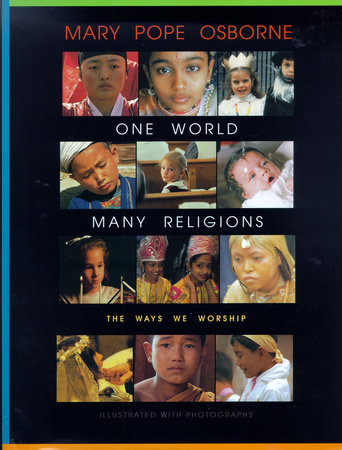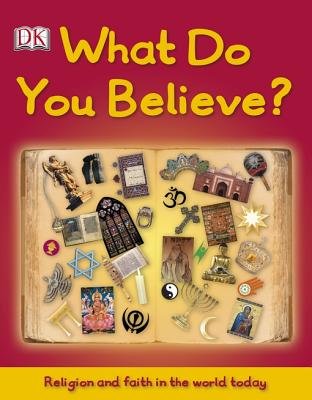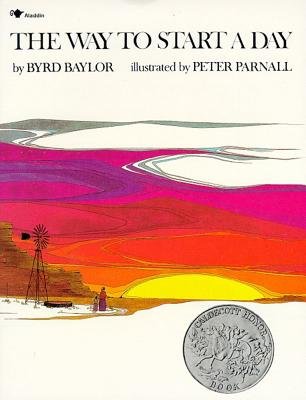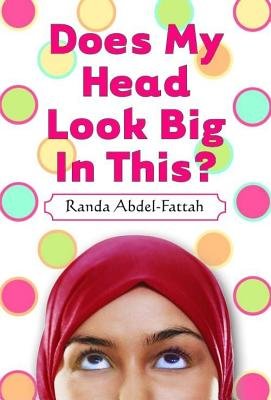A Question of Faith: Books and Resources to Help Us Talk to Our Kids About Religion and Spirituality
by Olugbemisola Rhuday-Perkovich
I didn’t grow up in a religious household. Well, maybe I did. Sort of. My mother had been raised Catholic, and we knew that; she returned to that faith a few years before she died, at 49. My father had been raised Muslim but had become an atheist by the time I was born. Now he runs a Bible bookshop. As children, my sister and I went to church once in a while, with my mother, or with her family and friends. In middle school, my dad assigned me readings from Bertrand Russell’s Why I Am Not a Christian. Sometimes people around me made proclamations, and others scoffed. My grandmother and aunties had whole Psalms memorized; it was not until I studied the Bible as an adult that I realized how many of their sayings were not just them sounding full of wisdom, and a little grand. But we didn’t really have conversations about religion or faith during my childhood. I wasn’t a talky kid anyway. I kept my wonderings, questions, and somewhat superstitious ideas of God to myself. Still, I had them.
Now, I do have a talky kid, and have been challenged by her questions, ideas, and thoughts about spirituality, faith, and religion. She has been raised in a particular faith, and lives in a world that includes many. Studies show that the American religious landscape has changed drastically over the years. Mainline Christianity is reportedly “on the decline,” and the number of Americans who declare “no religious affiliation” is rising. The numbers of residents who practice faiths such as Hinduism, and Islam, are growing.1
For some parents, it’s the hardest Talk. The one about what we believe. What they believe. Who’s “right,” who’s going where, and who decides. All of those potential hazards. And then there’s the personal baggage, perhaps from our own parents and childhoods. That can be a heavy load. Many of us have changed our minds about religion at one point or another. How can we offer guidance to our kids when we’re still figuring it out ourselves?
For others, it’s simple. We teach and share what we believe, and that’s it. Across the world, sharing a faith tradition with our children is essential. We may teach the stories and the sacred of our spiritual heritage as naturally as we teach our children to eat, or to walk. But even then, how do we help them navigate a spiritually multicultural world?
Others would prefer to leave this area of our kids’ lives to a process of self-discovery, allow them to make these decisions on their own, in their own time. So how do we help them interact and respond to those with definite and sometimes dogmatic ideas on the subject? And how do we all help our children process the messages they receive from media sources about religion and faith, its connections to conflict, history, and culture. How do we share what has been meaningful to us, but spare them the faith-related hurts that we may have suffered?
Some Tips for the Talk
1. Live in the Questions
“Who is God?” “Where do we go when we die?” “Can I go to church with Stacey?” “Charles called George a terrorist because he’s a Muslim.” “Why is that man wearing a turban?” Our tendency can be to hush children up when they approach the subject, because we don’t have answers neatly lined up and ready to deliver, or we’re afraid of what others will think, or we just have no idea what we think ourselves.
“All children, by the time they are age five have a concept of God, whether or not we’ve talked about God to them,” says Rabbi and author Sandy Eisenberg Sasso as she discusses the spirituality of parenting. If your child broaches the subject, find out a little more about what ideas they’ve developed and how they got them. Respect your child’s questions, ask your own, have a conversation. Be honest when you don’t feel you have “the answer,” when you feel you don’t understand, and be willing to explore questions together. Art can be a great way to explore and examine the many ways humans express their spirituality — visit museums to share ideas of faith in history and a variety of cultures.
2. Share Stories
Share some of the spiritual stories, rituals, or traditions from your own background, and be honest about how you’ve felt about them over the years. When you don’t feel comfortable or ready to share, say so. While holidays and celebrations can be a great introduction to faith and belief, go beyond them to explore a variety of religious texts together, perhaps visit spiritual sites and/or houses of worship, or watch services on YouTube to emphasize the human side of what can seem abstract and distant. Series like the Amma, Tell Me books and the Start-up Religion titles, with titles like Visiting a Gurdwara, Belonging, Places of Worship, and Celebrating Harvest promote understanding and respect.
3. Recognize and Respect Diversity
“Not believing in God is nothing to be ashamed of, but being open about our disbelief does — I believe — require a bit of finesse,” writes Wendy Thomas Russell, author of Relax, It’s Just God. Ground conversations on faith and spirituality in respect, not fear. Faith traditions of indigenous people are often marginalized or “otherized,” atheists and secular-focused folk are sometimes treated as people who just “haven’t gotten there yet.” Recognize that when it comes to religion, there are many systems and practices; be aware of framing any faiths as “major” or “minor”.
-
Resources for Discussing Faith and Spirituality with Kids
-
The Spiritual Child
Miller’s premise that there is a scientific link between health and spirituality might have strong appeal for those who want to raise children with a sense of the spiritual. Includes family stories, exercises, and advice.
-
Ethics for the New Millenium
Available from:The Dalai Lama lays out a moral system of living “based on universal rather than religious principles” and the idea of basic human goodness being a catalyst for positive action in the world.
Also available from: -
One World, Many Religions
Seven religious faiths (Judaism, Christianity, Islam, Hinduism, Buddhism, Confucianism, and Taoism) are featured in this book for middle-grade readers that includes full color photographs, maps, and timelines to help provide context.
-
What Do You Believe?
This book goes beyond religion to include ancient and modern philosophy. Some reviewers note that while it includes atheists, agnostics, etc., certain sections assume a concept of God.
-
Picture Books for Young Readers
-
The Way to Start a Day
Celebrating a variety of rituals and everyday practices, Baylor’s tribute to the many ways people around the world greet the morning won a Caldecott Honor for Parnall’s illustrations.
-
Books for Middle Grade Readers
-
The Book of Everything
Thomas sees things — a neighbor witch’s magic, his father’s abuse of his mother, Jesus. He comes to develop a way of thinking and living “based on human sympathy and compassion above all else." And then he discovers how happiness begins: “with no longer being afraid.”
-
8th Grade Superzero
In my debut novel, Reggie “Pukey” McKnight is trying to figure things out — if God cares, why are some people homeless? Why is his former best friend now his worst enemy? And who gets to be a superhero? As one reviewer notes, “Reggie might see himself as a wimpy kid, but he’s anything but as he steps up to new challenges and confronts big questions about doing the right thing in a tough world.”
-
Young Adult Books
-
Godless
Jason Bock is an agnostic-maybe-atheist who decides to invent a new religion with a water tower as its god. This book raises interesting questions about faithfulness, control, and ways of worship.
-
Does My Head Look Big In This?
When 16-year-old Amal decides to wear the hijab as a visible sign of her faith, everyone in her life has an opinion. “It became apparent to me that the only time Muslim females appeared as heroines in books were as escapees of the Taliban, victims of an honour killing, or subjects of the Saudi royalty! I wrote Does My Head Look Big In This? because I wanted to fill that gap. I wanted to write a book which debunked the common misconceptions about Muslims and which allowed readers to enter the world of the average Muslim teenage girl and see past the headlines and stereotypes … and have a giggle in the process!” says Abdel-Fattah.
[1] Lipka, Michael (2015, May 12). “5 key findings about the changing U.S. religious landscape“









